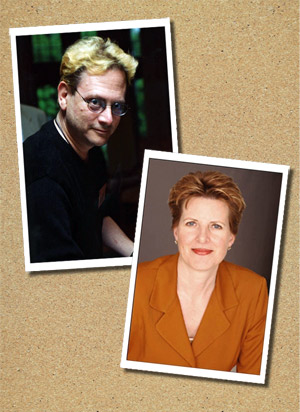Say 'Cheese' Why you need a professional photo

Mark G. Auerbach (top),
Ruth Stevens (bottom)
PRIME submitted photos
By Mark G. Auerbach
Special to PRIME
As you plan ahead this New Year, it's a good time to build up your photo files. Do you have a good photograph of yourself for your website, Facebook, Google+, LinkedIn, and Twitter? Do you have a good head shot to include with media releases about your business? What about your website?
Ruth Stevens, an international business-to-business marketing consultant at E-Marketing Strategy (
http://ruthstevens.com/), often speaks to groups about joining the ranks of the successfully self-employed.
"Your visual identity includes not only your company logo, but also your headshot. To present yourself professionally, you should have your headshot photographed professionally. Wear the kind of clothes that you would wear to a business meeting, and strive to come across as friendly and welcoming, in your expression. Be sure you add your professional photo not only to your company website, but also to your LinkedIn profile".
She's right. So, where to start?
Actors and artists know how to self-promote, because they have to in order to win a coveted place in an audition. (Remember the tableau in "A Chorus Line"?)
I called my friend and colleague Jeffrey Dreisman, the Broadway actor ("A Few Good Men") turned teacher, and now casting partner at McCorkle Casting in New York City, (
http://home.earthlink.net/~pmcdrize1/), the national agency that regularly casts shows for Broadway, national tours, and the most important regional theatres.
"Like an actor, you are your own product and brand," Dreisman said. "And self-branding is essential if you want to get your product out there. Skip the "selfies" and quick photographs shot by your neighbor, your nephew, or a talented amateur photographer, and hire a professional photographer, one who is proficient at shooting headshots."
The adage, "You get what you pay for" is always true. You can find good photographers through your local advertising club, creative industries listings, or by word-of-mouth.
Dreisbach recommends that you have photos done in color with a neutral background that doesn't detract from "you, the product." He also recommends that you project the person you want to be perceived as.
"If you'll be working in a clinical environment – law, insurance, corporate entities, then don't glam up," Dreisbach said. "If you work in the creative industries, be more creative. Your photo is your calling card."
Michael Zide, the Amherst, Mass.-based photographer, (
http://michaelzide.com/) is a pro. He's photographed the famous from Shirley Chisholm to the Emperor of Japan. While I was public relations manager for New England Public Radio, he photographed staff, special events, performers on our events series, and our annual used record sale on the Amherst Town Common. (He photographed me; I use his headshot).
"Once you've found your photographer," Zide said, "know the process. Most photography for commercial purposes is done digitally. You generally pay for a 'sitting fee.' That's a specific time period in which the photography takes place. Your time may or may not include indoor and outdoor settings. Negotiate that in advance. Bring your outfit changes, make-up, hair product, brushes, and other items with you".
Zide added "Then, the photographer gives you a contact sheet with all of the photos, and you get to select the ones that you want brought to a finished state.
As Zide explained, "You then pay for a digital file of photos that you and your photographer choose. They may be retouched. Negotiate in advance the fees and who owns the photos and the wording of the photo credit."
Zide reiterated that, in your headshot, "You want to project yourself as warm, professional, and accessible". He advises that black and white clothes are difficult to photograph. "Choose a professional look. Men, make sure your tie is correctly knotted and that your shirt, well pressed, has a collar that fits. Also remember to shave just before you head for the sitting. Some beards grow fast, and five o'clock shadow isn't your best option. Women, stay away from patterns and fluorescent colors. Make sure your outfit is one that will remain stylish for the several years. Go for solids."
Once you've got the photos done, make sure they're in a useable format. Most newspaper people prefer a JPEG format.
Know what format the media you send the photo to prefers. It all depends on the final output of the publication. If they only print in black and white, use black and white. If they print in color, use color.
Some other tips for building the best photo and some resources:
• Tips for great headshots: These can be found online at
>http://www.ericcalvi.com/tips-for-great-headshots// .
• Tips for women on what to wear: These can be found online at
http://leadersinheels.com/style/what-to-wear-for-business-headshots .
Mark G. Auerbach is principal at Mark G. Auerbach Public Relations, a Springfield, Mass.- based marketing, public relations, development and events consultancy. You can find more information about Auerbach at Facebook and LinkedIn. He is also a regular contributor to the blog "Succeeding in Small Business," where this article originally appeared;
www.succeedinginsmallbusiness.com/.

